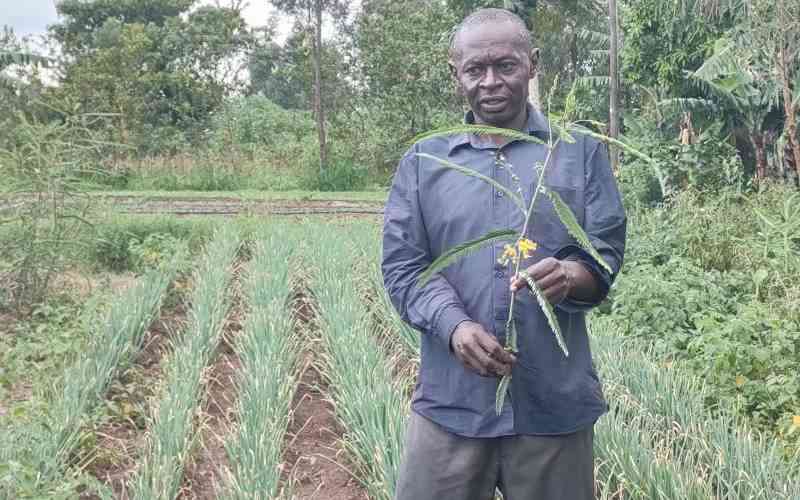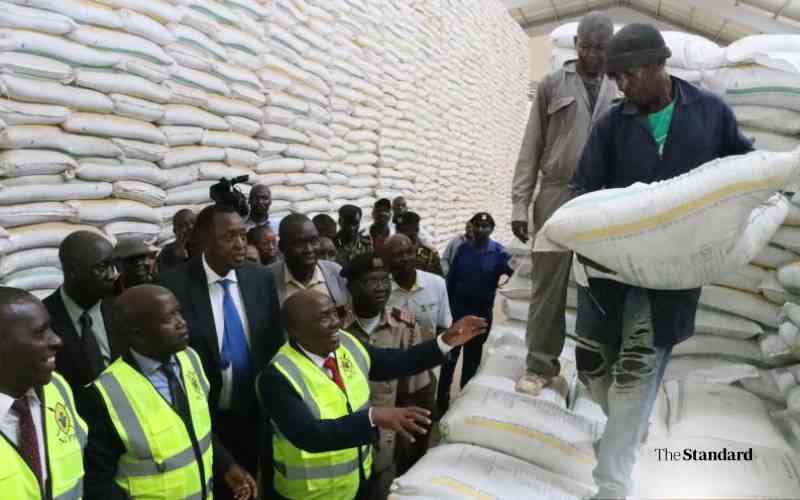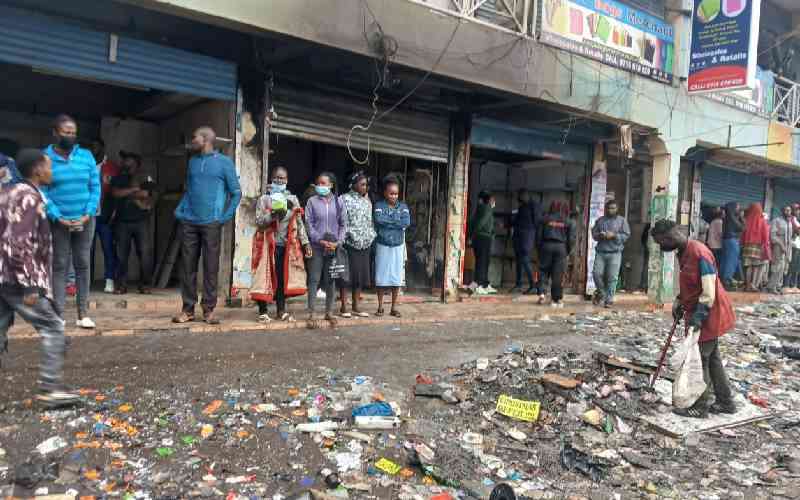
The heavy rains of March and May in 2024 left a trail of destruction in their wake, submerging and rendering vast tracks of agricultural heartlands inaccessible across the country, including Western, Nyanza, Coastal, Rift Valley and Central regions.
As rains wreaked havoc and thousands of farmers lost crops to flooding, it became clear that food prices would soon soar due to the widespread destruction and significant losses in the agricultural investments.
Mary Aketch’s farm in the Indangalasia area of Matungu, Kakamega County, remained untouched, despite being in one of the areas hardest hit by the heavy floods.
She recalls suffering the effects of floods during heavy downpours in previous years. Living on a sloping land, Mary constantly struggled with soil erosion.
“I have suffered huge losses in both heavy and light rain seasons. My farm sits on slightly sloping ground, so whenever it rained, the soil would wash downhill towards the river, carrying my crops with it,” she recalls.
At times, Mary found herself at a crossroads, “If l chose not to plant for fear of floods, l would have no food. But when l did plant, the rains would come, trigger soil erosion and wash away my crops, resulting in total loss of my investment in the farm.”




Her reprieve came six years ago, when she was introduced to a regenerative agriculture programme implemented by SNV Netherlands Development Organisation in the area. She explains, when the organisation came, it mobilised local farmers and farmer groups, offering them training in conservation agriculture.
One of the key benefits of the programme, Mary explains, is the control of soil erosion. In Western Kenya, one of the regions where the programme is being implemented, it’s evident that farmers are at various stages of adopting regenerative farming. Some are just beginning land preparation, while others are already weeding, irrigating, harvesting and selling either raw produce or value-added products.
Regenerative agriculture refers to a variety of practices that vary depending on region, location and production systems that aim to improve both the livelihoods of people and environmental conservation, with a strong focus on sustainable production systems.
These practices include mulching, cover cropping, inter-cropping, minimum tillage, agro-forestry, the use of organic manure, soil and water conservation and crop rotation.
On her farm, Mary grows a diverse range of crops including sweet potatoes, onions, yams, tomatoes, bananas, desmodium, nappier grass, groundnuts, Mombasa grass, coriander and cowpeas.
She also cultivates traditional vegetables, such as managu (black nightshade), sagaa (spider plant), terere (amaranth), mito (slender leaf) and mrenda (jute mallow), which she says contribute significantly to her family’s nutrition. Some of the produce is sold to generate income.
Mary explains, in the past her family had grown sugar cane since the 70s, a practice that has degraded the soil due to the continuous use of synthetic fertilisers.
She points out: “Pumpkins, sweet potatoes and Mombasa grass are some of the cover crops in my farm that help control soil erosion. They also act as mulches. Pumpkin leaves are eaten as vegetables.”
No more expensive fertiliser
Stay informed. Subscribe to our newsletter
She no longer relies on agrochemicals to manage pests. Nowadays, Mary plants onions and desmodium, which repel harmful insects and pests from her crops. This shift saves her the expense of buying costly agrochemicals.
Instead of chemical fertilisers, Mary now makes her manure from farm waste. She also uses cow dung from her livestock to enrich the soil. Some crops, such as sweet potatoes, double as livestock feeds, making the farm more sustainable and resource-efficient.
Kelvin Yongo, a Project Officer with SNV, explains the programme promotes over 17 regenerative agriculture technologies to support farmers. “We promote technologies that focus on water conservation, such as drip irrigation systems that use minimal water, solar-powered irrigation and solar drying technologies. For soil health, we encourage the use of compost manure and other organic farm wastes,” he explains.
To conserve soil, Yongo advises farmers on sloppy land to construct terraces, use sunken beds in drier regions and apply mulching to help retain moisture around plants.
In promoting seed systems, Yongo emphasises the importance of farmers accessing certified and clean seeds. “The benefits of using clean, certified seeds include guaranteed high yields and reduced risks of spreading pathogens from one farm to the other,” he says.
He explains, the programme collaborates with agro-vet suppliers to provide clean seeds. In addition, they have also trained farmers and farmer-leaders in clean seed production through a seed bank based in Vihiga.
“Farmers are now able to extract, store and monitor seeds for diseases and pests. This ensures they produce high-quality seeds. These seeds are not for sale, but for personal use, and farmers are free to exchange among themselves,” states Yongo.
He says SNV trained farmers for a year before offering tailored support based on individual or group’s needs through providing seeds to those without, fertiliser to others and pesticides where necessary.
Dr Oscar Koech from the University of Nairobi Department of Land Resource Management & Agricultural Technology (LARMAT) describes regenerative agriculture as a variety of practices that vary depending on region, location and production systems that aim to improve both the livelihoods of people and environmental conservation, with a strong focus on sustainable production systems.
The concept, Dr Koech explains, is not new to traditional farmers. “However, with the recent intensification of production systems, most farmers abandoned regenerative practices and moved to an intensive system where organic fertilisers and mono cropping was intensified,” he explains.
Further, regenerative agriculture practices can be applied in all agro-ecological zones- from the arid and semi-arid areas to humid and sub-humid regions. These practices are tailored to suit local conditions, including the availability of technologies and specific environmental needs.
“For example, one of the common practices in regenerative agriculture is zero tillage, which minimises soil disturbance. This is often combined with cover cropping and crop rotation, ensuring that land is never left bare in any season. Such practices promote soil conservation by maintaining continuous plant cover, which protects the land from degradation,” explains Dr Koech.
Better quality crop
According to the lecturer, regenerative agriculture is applicable not only in croplands but also in pasturelands and mixed farming systems. In croplands, efforts to increase soil fertility and maintain ground cover involve the integration of leguminous crops, such as beans and groundnuts, as cover crops alongside main crops, such as maize.
Similarly, in pastureland, legumes, such as desmodium, Lucerne, alfalfa and other forage legumes are mixed into grasslands. These legumes help improve soil fertility through nitrogen fixation, supporting sustainable fertility management and resulting in better quality crop and forage yields.
Shiembekho Shiepamba Self-Help Group is one of the farmer groups that has benefited from SNV’s regenerative agriculture training programme. Today, they are engaged in value addition and selling their products.
Frankline Okome Ometty, a group member, says the journey began with efforts to restore soil fertility that had been severely depleted by years of sugar cane farming, repeated maize monoculture and heavy reliance on synthetic fertilisers. The soil could no longer support the growth of any crop.
Through Farmer Field Schools (FFS) and demonstration plots, in Mayoni Ward, Matungu Sub-County, the group was introduced to sustainable practices such as crop diversification, crop rotation and use of cover crops, such as legumes and grasses. “Instead of growing maize we were used to, we diversified into crops, such as soya beans, sweet potatoes, bananas, groundnuts, sorghum, beans, pumpkin, and indigenous vegetables,” Ometty explains.
Since 2023, the group has been adding value to their farm produce and selling products from their shop at Mayoni shopping centre, along Mumias-Bungoma Road. Ometty shares, they process a nutritious flour blend made from sorghum, maize, cassava and amaranth, which has gained popularity in schools and hospitals.
They also process snacks, such as grits and crunches from soya beans, while mucuna is ground into powder consumed as a tea beverage and herbal medicine, especially popular among people with diabetes and women experiencing menstrual pains.
From roselle, the group makes a juice similar to Ribena, while herbs like rosemary and lemongrass are dried and packaged for herbal tea. Ometty boasts, “Our products are natural and chemical-free, which has attracted health-conscious buyers concerned about lifestyle diseases linked to chemical use in conventional farming.”
Rosemary Okello, a facilitator with the group, expresses gratitude for SNV’s training and support. “We were sitting on a goldmine without realising it. Now we are producing more, adding value and making money- something we never imagined possible. We no longer incur costs of purchasing seeds, fertiliser, pesticides and other inputs, because we generate them from our own farm waste,” she says.
Through the new farming practice, she discloses the group now earns at least Sh20,000 per month from their products. The money is saved and used to provide loans to members for personal investments in other income-generating activities.
Etete Royalty Group is the latest beneficiary of SNV regenerative agriculture training programme and has just started to implement the knowledge gained.
During a recent visit, the group’s farm was a beehive of activity as members prepared harrows, ridges and applied compost manure in readiness for planting.
Hamisi Olwenga, a member of the group says their main focus is to plant cover crops to combat soil erosion, which has been a major challenge. Secondly, is to plant nitrogen-fixing crops to improve soil fertility. “We are determined to succeed. During the training, we visited farmers and groups already practicing regenerative agriculture and saw the benefits firsthand. We want to follow in their footsteps, and hopefully surpass their success in productivity,” he promises.
Boaz Were, a beneficiary of the programme, says he had been planting maize for over 20 years, mainly for household consumption and occasionally for sale to earn some money, on his three-acre farm in Emukangu village of in Lurambi Sub County.
In 2020, he transitioned to biodiversity farming. He began growing sweet potatoes, beans, nappier grass and indigenous spring onions and indigenous vegetables, gooseberry, dhania, paw paws and mangoes.
Were sells most of his produce in Kakamega town. “Although l grow various crops, indigenous vegetables, especially black nightshade, spider plant - amaranth and slender leaf are in the highest demand,” he says.
He controls pests on his farm using push-pull technology. This involves intercropping spring onions with other crops, which naturally repel (push) pests away, while planting nappier grass around the edges of the farm attracts and traps (pull) the pests.
He also grows gooseberries, which not only provide nutritional value to his family, the berries are sold as traditional medicine believed to help manage heart disease. “Regenerative agriculture may help address emerging threats in agriculture such as pests, diseases and invasive species by creating a more resilient and balanced farming environment,” Dr Koech notes.
In light of the current impacts of climate change, there is a growing need for sustainable agricultural systems to assist communities in adapting, and regenerative agriculture stands out as a key solution. “There is an urgent need to strengthen capacity development and create a supportive environment, especially for rural and vulnerable communities. The need to diversify food systems following the practice is urgent, both for crop systems and the integrated crop-livestock systems,” emphasises Dr Koech.
The ultimate goal of the system in increase crop yields for the farmers, in a sustainable system that reduces environmental footprints like carbon emissions, which are known to contribute to climate change impacts.